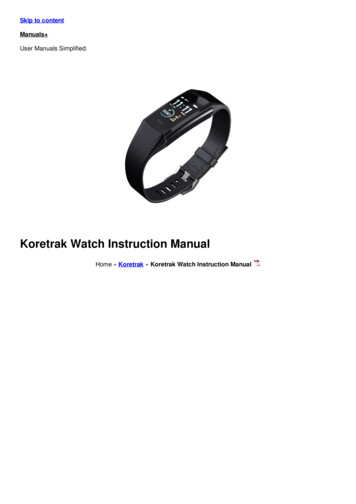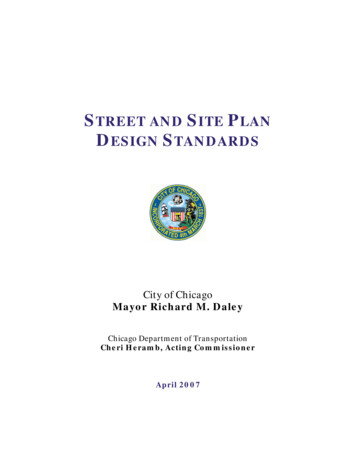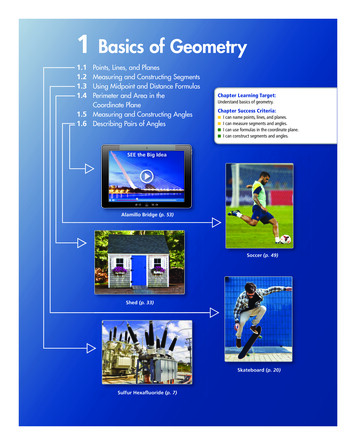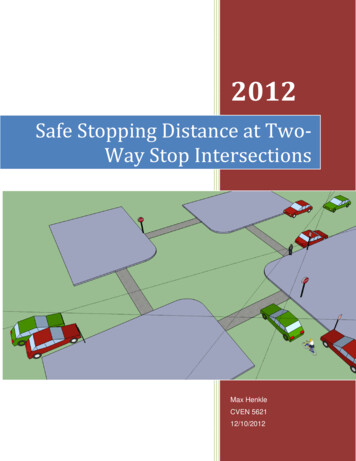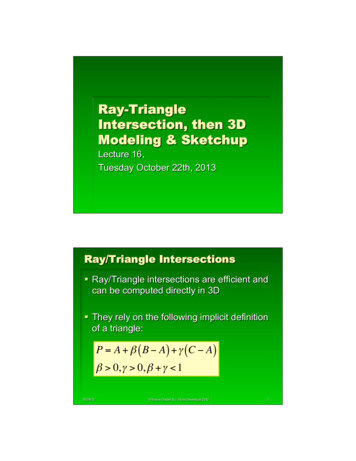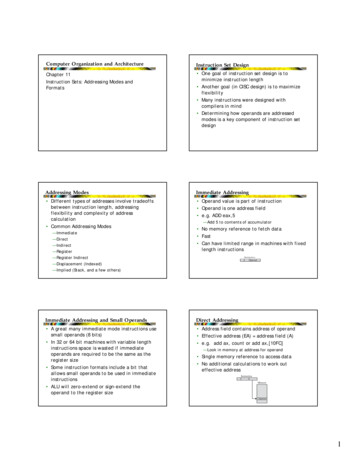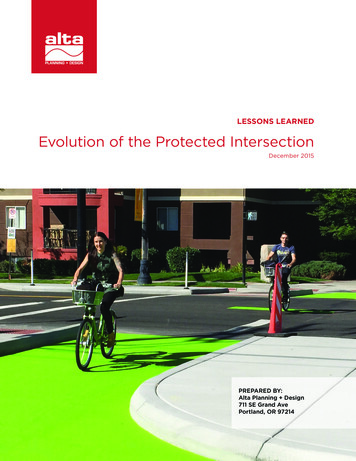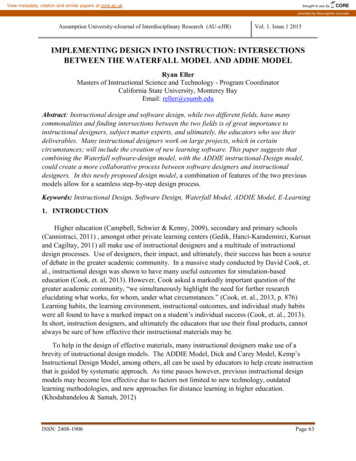
Transcription
View metadata, citation and similar papers at core.ac.ukbrought to you byCOREprovided by Assumption JournalsAssumption University-eJournal of Interdisciplinary Research (AU-eJIR)Vol. 1. Issue.1 2015IMPLEMENTING DESIGN INTO INSTRUCTION: INTERSECTIONSBETWEEN THE WATERFALL MODEL AND ADDIE MODELRyan EllerMasters of Instructional Science and Technology - Program CoordinatorCalifornia State University, Monterey BayEmail: reller@csumb.eduAbstract: Instructional design and software design, while two different fields, have manycommonalities and finding intersections between the two fields is of great importance toinstructional designers, subject matter experts, and ultimately, the educators who use theirdeliverables. Many instructional designers work on large projects, which in certaincircumstances; will include the creation of new learning software. This paper suggests thatcombining the Waterfall software-design model, with the ADDIE instructional-Design model,could create a more collaborative process between software designers and instructionaldesigners. In this newly proposed design model, a combination of features of the two previousmodels allow for a seamless step-by-step design process.Keywords: Instructional Design, Software Design, Waterfall Model, ADDIE Model, E-Learning1. INTRODUCTIONHigher education (Campbell, Schwier & Kenny, 2009), secondary and primary schools(Cannistraci, 2011) , amongst other private learning centers (Gedik, Hanci-Karademirci, Kursunand Cagiltay, 2011) all make use of instructional designers and a multitude of instructionaldesign processes. Use of designers, their impact, and ultimately, their success has been a sourceof debate in the greater academic community. In a massive study conducted by David Cook, et.al., instructional design was shown to have many useful outcomes for simulation-basededucation (Cook, et. al, 2013). However, Cook asked a markedly important question of thegreater academic community, “we simultaneously highlight the need for further researchelucidating what works, for whom, under what circumstances.” (Cook, et. al., 2013, p. 876)Learning habits, the learning environment, instructional outcomes, and individual study habitswere all found to have a marked impact on a student’s individual success (Cook, et. al., 2013).In short, instruction designers, and ultimately the educators that use their final products, cannotalways be sure of how effective their instructional materials may be.To help in the design of effective materials, many instructional designers make use of abrevity of instructional design models. The ADDIE Model, Dick and Carey Model, Kemp’sInstructional Design Model, among others, all can be used by educators to help create instructionthat is guided by systematic approach. As time passes however, previous instructional designmodels may become less effective due to factors not limited to new technology, outdatedlearning methodologies, and new approaches for distance learning in higher education.(Khodabandelou & Samah, 2012)ISSN: 2408-1906Page 63
Assumption University-eJournal of Interdisciplinary Research (AU-eJIR)Vol. 1. Issue.1 2015Similarly, software design models are used in the greater world of software engineering anddesign to create programs, applications, and software that takes less renditions for a strongfinished product. Models such as the Waterfall Model, V-Model, Dual Vee model, amongstothers, help to give users a guided approach to engineering design and creation of their givenproduct. Even though software engineering design models have proven effective (Gorschek,Tempero & Angelis, 2014), many senior designers do not use a systematic approach to design,unless they have a significant academic background (Groschek, Tempero & Angelis, 2014).With the creation of open-source educational technology, and its prevalent use in highereducation, the author recommends a combination of a both the ADDIE instructional designmodel and the Waterfall software design model. The author believes that a combination of thetwo models will allow subject matter experts, instructional designers, and software engineers(who are informed by the prior two groups) to work in tandem with one another. The author hasselected these two models because of their history of usage, potential for successful combination,and their ease of use. (Molenda, 2003; Lott, 1997)2. THE ADDIE MODELThe ADDIE Model has a varied past rooted in the creation of instructional systems design(ISD) near the end of World War II. (Allen, 2006) In fact, there is no one “correct” form of theADDIE model, instead it is believed to have been developed over time by a slew of researchersand instructional designers. (Molenda, 2003; Allen, 2006; Tennyson & Michaels, 1991) Themodel itself stems from a systems engineering approach (Allen, 2006) and is focused on creatinga student-focused, yet instructional-designer driven creation of instructional materials, andultimately, instruction itself.The ADDIE Model is a five step model, where each letter in the acronym stands for astructured design process. Each step builds upon the last to allow the user to take a coherent andfocused approach to instructional design.The five steps in the instructional design model are as follows (Allen, 2006):1. Analysis: The first step of the design model is focused on finding out the basic needs ofthe learner to structure instruction upon. A learner analysis or survey is a commonapplication of this stage in the design process.2. Design: During this phase, instructional designers either develops plans for newinstructional materials or revise existing materials to better fit the current needs of thelearning group. Formative evaluations of instructional goals and strategies are used tocontinue to formulate learning materials and the course structure.3. Development: After the final design plan is in place, the development of the finallearning products can begin to take place. As each phase, material, or module is created,reviewers (internal review, students, teachers, subject matter experts) can provide insightfor continued formative evaluation.ISSN: 2408-1906Page 64
Assumption University-eJournal of Interdisciplinary Research (AU-eJIR)Vol. 1. Issue.1 20154. Implementation: After the entirety of the learning materials are created, implementationof instruction takes place.5. Evaluation: Formative evaluation, which takes place during each step of the designprocess, and summative evaluation, which takes upon completion of the implementationphase, allows the instructional designers to constantly improve the class, learningmaterials, or instructional software, both during its use and for future renditions.The hallmark of the ADDIE Model is that it is a model that allows the user to analyze theneed of instruction all the way to the completion and its outcome. As such, the model can beused in any educational or training-focused setting and each step is malleable to the needs of theinstructional designer, subject matter experts, and the intended users.3. THE WATERFALL MODELThe Waterfall Model stems back to research and design approaches created in 1970, byWinston Royce (Royce, 1970), as a formulaic approach to design that relied on each step beingcompleted before moving on to the next. Similar to the ADDIE Model, the Waterfall Model ismore of a collection of ideas from various scholars, focused on this approach to software design.The model allows the user to define the scope of their work and follows up the actual softwaredesign (Lott, 1997).The seven primary steps in the model can be described as (Royce, 1970):1. System Requirements: A detailed analysis of the operating system requirements, andlimitations, is first performed.2. Software Requirements: After delineating the system requirements, an outline ofsoftware functionalities and uses is created.3. Analysis: After the limitations and scope is created within the two previous confines, ananalysis is performed to determine if the software is filling user needs and specifications.4. Program Design: The complete overview of the software is now created and theoperating procedures can be described.5. Coding: The creation of the software and its functions begins.6. Testing: Software engineers and programmers test the functionality of the software to seeif its intended function is being addressed or if further coding will take place (or in somecases, a radical redesign of the program itself).7. Operations: Once testing is complete, installation and usage by the target audience canbe performed.Royce actually believed his own design to be too rigid and risky based on following thesesteps systematically (1970). The model is noted as being good for large projects, with limitedinteractivity due to the heavy amount of documentation, lengthy design timeframes, and vastamount of coding (Boehm, 1988). However, by limiting the design process to remain withineach step until adequate completion, the Waterfall Model aims to reduce costly redesigns andreworks of software. (Boehm, 1988)ISSN: 2408-1906Page 65
Assumption University-eJournal of Interdisciplinary Research (AU-eJIR)Vol. 1. Issue.1 20154. APPLICATIONS OF BOTH MODELS TO INSTRUCTIONAL DESIGNInstructional design is a growing field. With the advent of new learning technologies, acreation of a hybrid software-instructional design model will benefit the greater ISD field,software designers who create educational software and the end-users who receive not only aninstructionally sound course, but a completely functional program as well. As such, the authorrecommends a hybrid model based on the following ideas:i. Instructional Designers, who are also sound programmers, will be able to articulate their designprocess from a dual-perspective. By following the ADDIE Model, yet also stemming thecreation of their materials through the Waterfall Model (regardless of if they are creatingsoftware), they will be able to slow down their design process, limiting errors, and saving timeon redesigns of course structure, learning materials, and course goals and objectives.ii. The Waterfall Model can be applied to non-software design. If a designer is creating a course,he or she could very likely change the “system” requirement step of the model into the“institution” requirement. Thus, each step can be redefined as needed to fit the designer’s needs.iii. By creating a co-model, large instructional design projects can be systematically created withthe designers and programmers in mind. By adhering to a more rigid step-by-step process,institutional-level design projects can be completed with less need for complete overhauls. Inshort, checklists for both groups can be created to keep each stakeholder in line with the overalldesign objectives.5. PROPOSING A CO-MODELBy combining the two models, the author proposes that steps, and the processes within eachstep, of each model can coalesce for a cohesive model that allows a team of instructionaldesigner (and a potential team of software designers, if the project requires) a more simplistic,step-by-step design process. In Figure 1, the new co-model is proposed with a description ofeach new step. In the new model, an emphasis on the initial analysis is present. In many highereducation institutions, knowledge of what students need to learn to be successful, postgraduation, is lacking (Nunley, Bers, Manning, 2011). As such, the author recommends thatinstructional designers, and course instructors, regularly reassess learning needs and how theymeet institutional goals and objectives. This creates a three-way feedback loop betweenknowing what learners currently know, what the course instructor thinks his or her student mustknow, and how the necessary institutional outcomes (such as graduation requirements and degreecompletion timeframes) can be met in an effective manner. After a more thorough analysis tookplace, design could begin with design in regards to course outcomes, learning materials, and anysoftware needed to obtain these goals (this becomes magnified if the course is reliant ontechnology). Design of learning materials would not begin without the course outcomes beingcompletely solidified. Each phase of design would thus follow the Waterfall Model’srecommendation to not begin the next phase of design, without the previous being completed.Adopting from the ADDIE Model, formative evaluations could be done at the course, learningISSN: 2408-1906Page 66
Assumption University-eJournal of Interdisciplinary Research (AU-eJIR)Vol. 1. Issue.1 2015material, and software level as each part of the course was being finalized. Development andtesting would be able to take place after a complete design of the course and its materials werecreated. Development would also follow a strict pattern of completion before a newdevelopment phase would begin. Testing would be interwoven into this process, with a team oftesters (a sample student, instructor, subject matter expert) testing instructional content, whilesoftware would be tested by beta-testers.Figure 1: Co-Model Steps of DesignISSN: 2408-1906Page 67
Assumption University-eJournal of Interdisciplinary Research (AU-eJIR)Vol. 1. Issue.1 2015Lastly, a summative evaluation would take place once the entire course was created. Afterthe summative evaluation, if the course adequately meets the needs of the learners, has sounddesign, and has been tested for flaws, then it would be rolled out formally.6. CONCLUSIONSThe new Co-Model shared here gives instructional designers an opportunity to adopt both aninstructional design process, while also incorporating software design principles. Even if theinstructional designer learns that software design does not need to be present, adopting aspects ofthe Waterfall Model will allow designers to take a more fully-focused approach to their designs.Due to the model’s focus on completion before progression, it is arguable that fewer mistakeswill be made during any facet of the design process, from learning objectives to potentialsoftware design.By combining the two models, instructional designers will be familiar with the designpractices in the ADDIE Model. In short, separate teams of software designers and instructionaldesigners will have their needs met as content-creators, since this model aims to take bestpractices from both models.However, it is arguable that by combining these models, a potential user may beoverwhelmed by having to adopt a new style of design. As such, the author recommends that apotential user of the design principles shared here adapts the model to the needs of theirinstitution, design team, and ultimately, the students being served by them.REFERENCESAllen, W. (2006). Overview and evolution of the ADDIE training system. Advances inDeveloping Human Resources, 8(4), 430-441.Boehm, B. (1988). A spiral model of software development and enhancement. Computer, 21(5),61-72.Campbell, K., Schwier, R., & Kenny, R. (2009). The critical, relational practice of instructionaldesign in higher education: An emerging model of change agency. Educational TechnologyResearch and Development, 645-663.Cannistraci, L. (2011). The value of instructional technology in a K-12 district. DistanceLearning, 8(1). Retrieved fromhttp://go.galegroup.com/ps/i.do?id GALE%7CA284016023&v 2.1&u csumb main&it r&p AONE&sw w&asid 2d4375b0464a7344ddf536ad607a96d0Cook, D., Hamstra, S., Brydges, R., Zendejas, B., Szostek, J., et al. (2013). Comparativeeffectiveness of instructional design features in simulation-based education: Systematic reviewand meta-analysis. Medical Teacher, 35(1), 867-898.Gedik, N., Hanci-Karademirci, A., Kursun, E., & Cagiltay, K. (2011). Key instructional designissues in a cellular phone-based mobile learning project. Computers & Education, 58, 11491159. doi:doi:10.1016/j.compedu.2011.12.002Gorschek, T., Tempero, E., & Angelis, L. (2014). On the use of software design models insoftware development practice: An empirical investigation. The Journal of Systems andSoftware, 95, 176.ISSN: 2408-1906Page 68
Assumption University-eJournal of Interdisciplinary Research (AU-eJIR)Vol. 1. Issue.1 2015Khodabandelou, R., & Samah, S. (2012). Instructional design models for online instruction:From the perspective of Iranian higher education. Procedia - Social and Behavioral Sciences, 67,545-552. doi:10.1016/j.sbspro.2012.11.359Lott, C. (1997). Breathing new life into the waterfall model. IEEE Software, 14(5), 103-105.Nunley, C., Bers, T., & Manning, T. (2011). Learning outcomes assessment in communitycolleges. Illinois: National Institute for Learning Outcomes Assessment.Molenda, M. (2003). In search of the elusive ADDIE model. Performance Improvement, 42(5),34-36.Royce, W. (1970). Managing the Development of Large Software Systems. Proceedings of IEEEWESCON 26 (August): 1–9Tennyson, R. D., & Michaels, M. (1991). Foundations of educational technology: Past, presentand future. Englewood Cliffs, NJ: Educational Technology Publications.ISSN: 2408-1906Page 69
The ADDIE Model, Dick and Carey Model, Kemp's Instructional Design Model, among others, all can be used by educators to help create instruction that is guided by systematic approach. As time passes however, previous instructional design . The five steps in the instructional design model are as follows (Allen, 2006): 1.
